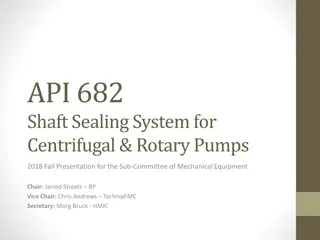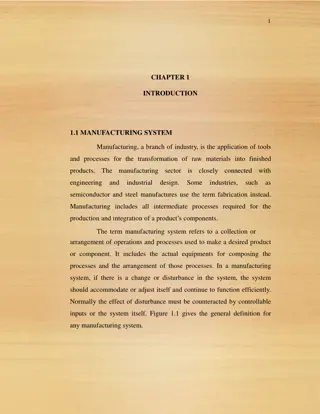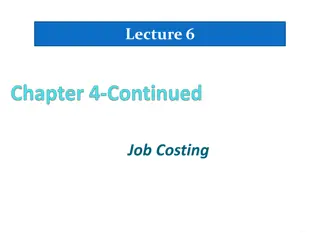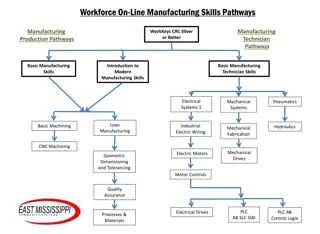Basic Hole and Shaft Systems in Manufacturing Processes
Basic Hole and Shaft Systems are essential procedures for determining mating part dimensions and tolerance information in manufacturing drawings. By knowing parameters such as Basic Size, Allowance, Hole Tolerance, and Shaft Tolerance, accurate and functional parts can be produced. This system ensures that parts fit together as intended. The Basic Hole System and Basic Shaft System involve calculations based on the maximum material condition to determine sizes, allowances, and tolerances for holes and shafts.
Download Presentation

Please find below an Image/Link to download the presentation.
The content on the website is provided AS IS for your information and personal use only. It may not be sold, licensed, or shared on other websites without obtaining consent from the author.If you encounter any issues during the download, it is possible that the publisher has removed the file from their server.
You are allowed to download the files provided on this website for personal or commercial use, subject to the condition that they are used lawfully. All files are the property of their respective owners.
The content on the website is provided AS IS for your information and personal use only. It may not be sold, licensed, or shared on other websites without obtaining consent from the author.
E N D
Presentation Transcript
IE-352 0.08 M A 8X 7.9 - 8.1 0.14 M A C M C 0.06 A 9.6 9.4 M42 X 1.5 - 6g 8X 45 0.1 M B M Manufacturing Processes 2 86 6.6 6.1 20.00 - 20.13 A C 0.14 Spring - 2016 B 44.60 44.45 Lecture (2) Lecture (2) Coordinate Dimensioning and Tolerancing 9.6 9.4 31.8 31.6 25.5 25.4 Ahmed M. El Ahmed M. El- -Sherbeeny Sherbeeny, PhD , PhD B 0.1 36 34 57.6 56.6 A Industrial Engineering Department Industrial Engineering Department King Saud University King Saud University 41.3 41.1 100 99 0.02 Coordinate Dimensioning Table of Contents Glossary Master Table of Contents Quit Return to the Previous Slide Coordinate Dimensioning Table of Contents Glossary Master Table of Contents Slide 1 Quit Return to the Previous Slide
Outline 1. Introduction 2. Basic Hole System 3. Basic Shaft System 4. American National Standard Fit Tables Coordinate Dimensioning Table of Contents Glossary Master Table of Contents Quit Return to the Previous Slide Coordinate Dimensioning Table of Contents Glossary Master Table of Contents Slide 2 Quit Return to the Previous Slide
Introduction - Basic Hole andBasic Shaft Systems The Basic Hole andBasic Shaft Systems are procedures for calculating and placing mating part dimensions and tolerance information on the drawing. This will assure that if the parts are manufactured according to the specifications on the drawing, they will fit together and function as intended. Four basic parameters must be known to use these systems: Basic Size, Allowance, Hole Tolerance, and Shaft Tolerance. Basic size is the hole or shaft at maximum material condition (MMC). All tolerance values are generated from that value. Allowance (the intentional difference between mating parts) is the minimum clearance or maximum interference. It can be positive (clearance) or negative (interference). Coordinate Dimensioning Table of Contents Glossary Master Table of Contents Quit Return to the Previous Slide Coordinate Dimensioning Table of Contents Glossary Master Table of Contents Slide 3 Quit Return to the Previous Slide
Introduction - Basic Hole andBasic Shaft Systems BASIC HOLE SYSTEM Allowance based on the hole at MMC 1. The basic size is always equal to the minimumhole size (Hole MMC). 2. Subtract the allowance from the basic size to get the maximum shaft size (Shaft MMC). 3. Apply the appropriate tolerances to the hole and to the shaft (Hole & Shaft lower material condition (LMC)). BASIC SHAFT SYSTEM Allowance based on the shaft at MMC 1. The basic size is always equal to the maximum shaft size. 2. Add the allowance to the basic size to get the minimum hole size. 3. Apply the appropriate tolerances to the shaft and the hole. Coordinate Dimensioning Table of Contents Glossary Master Table of Contents Quit Return to the Previous Slide Coordinate Dimensioning Table of Contents Glossary Master Table of Contents Slide 4 Quit Return to the Previous Slide
BASIC HOLE SYSTEM Coordinate Dimensioning Table of Contents Glossary Master Table of Contents Quit Return to the Previous Slide Coordinate Dimensioning Table of Contents Glossary Master Table of Contents Slide 5 Quit Return to the Previous Slide
Basic Hole System Using the Basic Hole System and the following data, complete the drawing by placing the appropriate dimensions on both the shaft and the hole. Nominal Size = 9/16 Allowance = .0006 Shaft Tolerance = .0009 Hole Tolerance = .0010 Coordinate Dimensioning Table of Contents Glossary Master Table of Contents Quit Return to the Previous Slide Coordinate Dimensioning Table of Contents Glossary Master Table of Contents Slide 6 Quit Return to the Previous Slide
Basic Hole System The basic size is determined by converting the nominal size into its decimal equivalent. The basic hole system always establishes the basic size as the minimum hole size. Remember, the smallest size limit always goes on the bottom in a stacked limits form. Basic Size = .5625 Allowance = .0006 Shaft Tolerance = .0009 Hole Tolerance = .0010 .5625 Coordinate Dimensioning Table of Contents Glossary Master Table of Contents Quit Return to the Previous Slide Coordinate Dimensioning Table of Contents Glossary Master Table of Contents Slide 7 Quit Return to the Previous Slide
Basic Hole System Subtract the allowance from the basic size to obtain the maximum shaft size (Shaft MMC). Place the value as the upper limit of the shaft dimension. Basic Size = .5625 Allowance = .0006 Shaft Tolerance = .0009 Hole Tolerance = .0010 .5625 Shaft MMC .5625 .0006 Basic Size Allowance Coordinate Dimensioning Table of Contents Glossary Master Table of Contents Quit Return to the Previous Slide Coordinate Dimensioning Table of Contents Glossary Master Table of Contents Slide 8 Quit Return to the Previous Slide
Basic Hole System Subtract the allowance from the basic size to obtain the maximum shaft size (Shaft MMC). Place the value as the upper limit of the shaft dimension. Basic Size = .5625 Allowance = .0006 Shaft Tolerance = .0009 Hole Tolerance = .0010 .5619 .5625 Shaft MMC .5625 .0006 .5619 Basic Size Allowance Shaft MMC Coordinate Dimensioning Table of Contents Glossary Master Table of Contents Quit Return to the Previous Slide Coordinate Dimensioning Table of Contents Glossary Master Table of Contents Slide 9 Quit Return to the Previous Slide
Basic Hole System Apply the tolerances to both the hole and the shaft to complete the dimensions; add the hole tolerance to the hole lower limit, and subtract the shaft tolerance from the shaft upper limit. Do the arithmetic and apply the values. Basic Size = .5625 Allowance = .0006 Shaft Tolerance = .0009 Hole Tolerance = .0010 .5619 .5625 Shaft MMC Shaft .5619 .0009 +.0010 Hole .5625 .5625 .0006 .5619 Basic Size Allowance Shaft MMC Coordinate Dimensioning Table of Contents Glossary Master Table of Contents Quit Return to the Previous Slide Coordinate Dimensioning Table of Contents Glossary Master Table of Contents Slide 10 Quit Return to the Previous Slide
Basic Hole System Apply the tolerances to both the hole and the shaft to complete the dimensions; add the hole tolerance to the hole lower limit, and subtract the shaft tolerance from the shaft upper limit. Do the arithmetic and apply the values. Basic Size = Allowance = Shaft Tolerance = .0009 Hole Tolerance = .0010 .5625 .0006 .5619 .5610 .5635 .5625 Shaft MMC Shaft Tol Hole Tol .5619 .5625 .0009 +.0010 .5610 .5635 Shaft .5625 .0006 .5619 Basic Size Allowance Shaft MMC Hole -.0006 -.0015 +.0010 -.0000 .5625 .5625 Values Referenced to Basic Size: Coordinate Dimensioning Table of Contents Glossary Master Table of Contents Quit Return to the Previous Slide Coordinate Dimensioning Table of Contents Glossary Master Table of Contents Slide 11 Quit Return to the Previous Slide
Basic Hole System For the values of the hole-shaft system given below, find the hole and shaft sizes using the basic hole system. Express the results in reference to the basic size and in the stacked format. Basic Size = 1-1/8 Allowance = .0025 Shaft Tolerance = .0015 Hole Tolerance = .0020 Coordinate Dimensioning Table of Contents Glossary Master Table of Contents Quit Return to the Previous Slide Coordinate Dimensioning Table of Contents Glossary Master Table of Contents Slide 12 Quit Return to the Previous Slide
Basic Hole System Nominal Size = 1-1/8 Basic Size = 1.1250 Allowance = .0025 Shaft Tolerance = .0015 Hole Tolerance = .0020 Hole 1.1250 Basic Size -.0025 Allowance .0015 1.1225 Max Shaft Shaft 1.1225 1.1210 Shaft Hole +.0020 -.0000 -.0025 -.0040 1.1250 1.1250 Values Referenced to Basic Size: Values expressed in The stacked format: 1.1225 1.1210 1.1270 1.1250 Coordinate Dimensioning Table of Contents Glossary Master Table of Contents Quit Return to the Previous Slide Coordinate Dimensioning Table of Contents Glossary Master Table of Contents Slide 13 Quit Return to the Previous Slide
BASIC SHAFT SYSTEM Coordinate Dimensioning Table of Contents Glossary Master Table of Contents Quit Return to the Previous Slide Coordinate Dimensioning Table of Contents Glossary Master Table of Contents Slide 14 Quit Return to the Previous Slide
Basic Shaft System Using the Basic Shaft System and the following data, complete the drawing by placing the appropriate dimensions on both the shaft and the hole. Nominal Size = 9/16 Allowance = .0004 Shaft Tolerance = .0008 Hole Tolerance = .0010 Coordinate Dimensioning Table of Contents Glossary Master Table of Contents Quit Return to the Previous Slide Coordinate Dimensioning Table of Contents Glossary Master Table of Contents Slide 15 Quit Return to the Previous Slide
Basic Shaft System The basic shaft system establishes the basic size as the maximum shaft size. Remember, the upper size limit always goes on top in a stacked tolerance expression. Nominal Size = 9/16 Basic Size = .5625 Allowance = .0004 Shaft Tolerance = .0008 Hole Tolerance = . 0010 .5625 Coordinate Dimensioning Table of Contents Glossary Master Table of Contents Quit Return to the Previous Slide Coordinate Dimensioning Table of Contents Glossary Master Table of Contents Slide 16 Quit Return to the Previous Slide
Basic Shaft System The minimum hole size (Hole MMC) is obtained by adding the allowance to the basic shaft size. Do the addition and place the dimension as the lower limit of the hole size. Hole MMC Nominal Size = 9/16 Basic Size = .5625 Allowance = .0004 Shaft Tolerance = .0008 Hole Tolerance = .0010 .5625 +.0004 .5629 .5625 .5629 Coordinate Dimensioning Table of Contents Glossary Master Table of Contents Quit Return to the Previous Slide Coordinate Dimensioning Table of Contents Glossary Master Table of Contents Slide 17 Quit Return to the Previous Slide
Basic Shaft System The process is completed by applying the tolerances to the respective components by subtracting the shaft tolerance from the shaft upper limit, and adding the hole tolerance to the hole dimension lower limit. Apply your results to the drawing. Shaft .5625 .0008 .5617 Shaft LMC .5639 Hole LMC Hole .5629 +.0010 Nominal Size = 9/16 Basic Size = Allowance = Shaft Tolerance = .0008 Hole Tolerance = .0010 .5625 .0004 .5625 .5617 .5639 .5629 Coordinate Dimensioning Table of Contents Glossary Master Table of Contents Quit Return to the Previous Slide Coordinate Dimensioning Table of Contents Glossary Master Table of Contents Slide 18 Quit Return to the Previous Slide
Basic Hole compared to Basic Shaft System The same basic size (.5625) was used calculations. Compare the two results for actual sizes of the shaft and the hole. for both .5619 .5610 .5635 .5625 Basic Hole System .5625 .5617 .5639 .5629 Basic Shaft System Coordinate Dimensioning Table of Contents Glossary Master Table of Contents Quit Return to the Previous Slide Coordinate Dimensioning Table of Contents Glossary Master Table of Contents Slide 19 Quit Return to the Previous Slide
STANDARD FITS Coordinate Dimensioning Table of Contents Glossary Master Table of Contents Quit Return to the Previous Slide Coordinate Dimensioning Table of Contents Glossary Master Table of Contents Slide 20 Quit Return to the Previous Slide
American National Standard Fit Tables Tremendous advantages have been gained by standardizing fits, and publishing them in tables. They are the means for establishing tolerances for any given size, type, or class of fit. Each of the possible fit options within the tables are prescribed according to their intended function. If the designer or engineer knows the functional requirements for the fit, a match can easily be found that conforms to the specific need. The standard provides choices for a series of types and classes of fits on a unilateral hole basis such that the fit produced by mating parts in any one class will produce approximately similar performance throughout the entire range of sizes. The standard fit tables are consistent with the basic hole system. It is important that you understand how the tables themselves can be used to satisfy functional specifications and provide dimensional data to be used on engineering drawings. The tables reflecting standard fits between mating parts may be found in virtually any design handbook, Machinery s Handbook, and in any reputable drafting manual. Coordinate Dimensioning Table of Contents Glossary Master Table of Contents Quit Return to the Previous Slide Coordinate Dimensioning Table of Contents Glossary Master Table of Contents Slide 21 Quit Return to the Previous Slide
American National Standard Fit Tables Standard fits fall into 3 major categories and 5 basic types of fits. Within each of these divisions there are several classifications of fits. The first category, Running and sliding fits, for instance, has nine different classifications of this specific type of fit. The second category, Location fits, is a broad category of standardized fits, within which there are 3 major sub-categories: clearance,transition, and interference fits. Finally, there is a category for Interference, or Force fits consisting of 5 different classifications. The five divisions of standard fits are designated by letters: CategoryType Classification Sliding Location LT = Location Transition Fits (Clearance through Interference) LN = Location Interference Fits Force FN = Force or Shrink Fits RC = Running/Sliding (Rotational or Reciprocal Motion) Clearance Fits (RC 1 - RC 9) LC = Location Clearance Fits (LC 1 - LC 11) (LT 1 - LT 6) (LN 1 - LN 3) (FN 1 - FN 5) The specification is complete when the category and the classification are combined, such as RC 3 or FN 5, and coupled with a specific diameter size. Coordinate Dimensioning Table of Contents Glossary Master Table of Contents Quit Return to the Previous Slide Coordinate Dimensioning Table of Contents Glossary Master Table of Contents Slide 22 Quit Return to the Previous Slide
Running and Sliding Fits* -- American National Standard RC 1 Close sliding fits are intended for the accurate location of parts which must assemble without perceptible play. RC 2 Sliding fits are intended for accurate location, but with greater maximum clearance than class RC 1. Parts made to this fit move and turn easily but are not intended to run freely, and in the larger sizes may seize with small temperature changes. RC 3 Precision running fits are about the closest fits which can be expected to run freely, and are intended for precision work at slow speeds and light pressures, but are not suitable where appreciable temperature differences are likely to be encountered. RC4 Close running fits are intended chiefly for running fits on accurate machinery with moderate surface speeds and pressures, where accurate location and minimum play are desired. Medium running fits are intended for higher running speeds, or heavy pressures, or both. RC 5 RC 6 Coordinate Dimensioning Table of Contents Glossary Master Table of Contents Quit Return to the Previous Slide Coordinate Dimensioning Table of Contents Glossary Master Table of Contents Slide 23 Quit Return to the Previous Slide
Running and Sliding Fits* -- American National Standard Basic hole system. Limits are in thousandths of an inch. Class RC 5 Standard Limits Class RC 1 Standard Limits Class RC 2 Standard Limits Class RC 4 Standard Limits Class RC 6 Standard Limits Class RC 3 Standard Limits Nominal Size Range in Inches Clearance Clearance Clearance Clearance Clearance Clearance Limits of Limits of Limits of Limits of Limits of Limits of Shaft e7 Shaft g4 Shaft g5 Shaft f7 Hole H8 Shaft e8 Hole H5 Hole H6 Shaft f6 Hole H8 Hole H9 Hole H7 0 - 0.12 0.1 + 0.2 - 0.1 0.1 + 0.25 - 0.1 0.3 + 0.4 - 0.3 0.3 + 0.6 - 0.3 0.6 + 0.6 - 0.6 0.6 + 1.0 - 0.6 0.45 - 0 - 0.25 0.55 - 0 - 0.3 0.95 - 0 - 0.55 1.3 - 0 - 0.7 1.6 - 0 - 1.0 2.2 - 0 - 1.2 0.12 - 0.24 0.15 + 0.2 - 0.15 0.15 + 0.3 - 0.15 0.4 + 0.5 - 0.4 0.4 + 0.7 - 0.4 0.8 + 0.7 - 0.8 0.8 + 1.2 - 0.8 0.5 - 0 - 0.3 0.65 - 0 - 0.35 1.12 - 0 - 0.7 1.6 - 0 - 0.9 2.0 - 0 - 1.3 2.7 - 0 - 1.5 0.24 - 0.40 0.2 + 0.25 - 0.2 0.2 + 0.4 - 0.2 0.5 + 0.6 - 0.5 0.5 + 0.9 - 0.5 1.0 + 0.9 - 1.0 1.0 + 1.4 - 1.0 0.6 - 0 - 0.35 0.85 - 0 - 0.45 1.5 - 0 - 0.9 2.0 - 0 - 1.1 2.5 - 0 - 1.6 3.3 - 0 - 1.9 0.40 - 0.71 0.25 + 0.3 - 0.25 0.25 + 0.4 - 0.25 0.6 + 0.7 - 0.6 0.6 + 1.0 - 0.6 1.2 + 1.0 - 1.2 1.2 + 1.6 - 1.2 0.75 - 0 - 0.45 0.95 - 0 - 0.55 1.7 - 0 - 1.0 2.3 - 0 - 1.3 2.9 - 0 - 1.9 3.8 - 0 - 2.2 0.71 - 1.19 0.3 + 0.4 - 0.3 0.3 + 0.5 - 0.3 0.8 + 0.8 - 0.8 0.8 + 1.2 - 0.8 1.6 + 1.2 - 1.6 1.6 + 2.0 - 1.6 0.95 - 0 - 0.55 1.2 - 0 - 0.7 2.1 - 0 - 1.3 2.8 - 0 - 1.6 3.6 - 0 - 2.4 4.8 - 0 - 2.8 1.19 - 1.97 1.97 - 3.15 *From ANSI B4.1--1967 (R 1987). Larger diameters and RC 7 through RC 9 not included in this presentation. Coordinate Dimensioning Table of Contents Glossary Master Table of Contents Quit Return to the Previous Slide Coordinate Dimensioning Table of Contents Glossary Master Table of Contents Slide 24 Quit Return to the Previous Slide
Using the Standard Fit Tables to Assign Dimensions to Mating Parts Using the standard fit tables, determine the limits for a nominal 9/16 (.5625) inch diameter RC 4 fit between a shaft and a hole. Place the dimensions on the drawing using stacked limits form. Coordinate Dimensioning Table of Contents Glossary Master Table of Contents Quit Return to the Previous Slide Coordinate Dimensioning Table of Contents Glossary Master Table of Contents Slide 25 Quit Return to the Previous Slide
Using the Standard Fit Tables to Assign Dimensions to Mating Parts First, identify the size range in the left-most column in the fit table for RC fits. The row that identifies the size range that will include the designated diameter in the problem have been highlighted. Note that this column is specified in inches. All other columns in the table are specified in thousandths of an inch. Nominal Size Range in Inches 0 - 0.12 0.12 - 0.24 0.24 - 0.40 0.40 - 0.71 0.71 - 1.19 1.19 - 1.97 1.97 - 3.15 Coordinate Dimensioning Table of Contents Glossary Master Table of Contents Quit Return to the Previous Slide Coordinate Dimensioning Table of Contents Glossary Master Table of Contents Slide 26 Quit Return to the Previous Slide
Using the Standard Fit Tables to Assign Dimensions to Mating Parts Next, read across the table on the row that is highlighted to identify the parameters for an RC 4 fit. Because of the lack of space, the columns for fits other than the RC 4 are excluded. Class RC 4 Standard Limits Nominal Size Range in Inches Clearance Limits of Shaft f7 Hole H8 0.3 + 0.6 - 0.3 1.3 - 0 - 0.7 0.4 + 0.7 - 0.4 1.6 - 0 - 0.9 0.5 + 0.9 - 0.5 2.0 - 0 - 1.1 0.6 + 1.0 - 0.6 2.3 - 0 - 1.3 0.8 + 1.2 - 0.8 2.8 - 0 - 1.6 0 - 0.12 0.12 - 0.24 0.24 - 0.40 0.40 - 0.71 0.71 - 1.19 1.19 - 1.97 1.97 - 3.15 Coordinate Dimensioning Table of Contents Glossary Master Table of Contents Quit Return to the Previous Slide Coordinate Dimensioning Table of Contents Glossary Master Table of Contents Slide 27 Quit Return to the Previous Slide
Using the Standard Fit Tables to Assign Dimensions to Mating Parts The first column for a class RC 4 fit establishes the limits of clearance. The number on top is the allowance at MMC. Converted to inches (by moving the decimal 3 places to the left), this number would be .0006, six tenths of one-thousandth, or six ten-thousandths. The number below (2.3) is the maximum clearance at LMC, or twenty-three ten-thousandths (.0023). Class RC 4 Standard Limits Nominal Size Range in Inches Clearance Limits of Shaft f7 Hole H8 0.3 + 0.6 - 0.3 1.3 - 0 - 0.7 0.4 + 0.7 - 0.4 1.6 - 0 - 0.9 0.5 + 0.9 - 0.5 2.0 - 0 - 1.1 0.6 + 1.0 - 0.6 2.3 - 0 - 1.3 0.8 + 1.2 - 0.8 2.8 - 0 - 1.6 0 - 0.12 0.12 - 0.24 0.24 - 0.40 0.40 - 0.71 0.71 - 1.19 1.19 - 1.97 1.97 - 3.15 Coordinate Dimensioning Table of Contents Glossary Master Table of Contents Quit Return to the Previous Slide Coordinate Dimensioning Table of Contents Glossary Master Table of Contents Slide 28 Quit Return to the Previous Slide
Using the Standard Fit Tables to Assign Dimensions to Mating Parts Notice that the Hole size, at its lower limit, reads - 0 . Therefore, use the basic size (nominal 9/16 inch, converted to its decimal equivalent, .5625) as the lower limit for the dimension of the hole. Class RC 4 Standard Limits Nominal Size Range in Inches Clearance Limits of Shaft f7 Hole H8 0.3 + 0.6 - 0.3 1.3 - 0 - 0.7 0.4 + 0.7 - 0.4 1.6 - 0 - 0.9 0.5 + 0.9 - 0.5 2.0 - 0 - 1.1 0.6 + 1.0 - 0.6 2.3 - 0 - 1.3 0.8 + 1.2 - 0.8 2.8 - 0 - 1.6 0 - 0.12 0.12 - 0.24 0.24 - 0.40 0.40 - 0.71 0.71 - 1.19 1.19 - 1.97 .5625 1.97 - 3.15 Coordinate Dimensioning Table of Contents Glossary Master Table of Contents Quit Return to the Previous Slide Coordinate Dimensioning Table of Contents Glossary Master Table of Contents Slide 29 Quit Return to the Previous Slide
Using the Standard Fit Tables to Assign Dimensions to Mating Parts For the upper size limit for the hole you will notice that the value on the chart is +1.0. This value when converted into inches equals one thousandth of an inch or ten ten-thousandths. Add the required .0010 to the basic size for the upper limit of the hole (.5625 + .0010 = .5635). This is the upper size limit of the hole, which can now be added to the drawing. It is added to the basic size value. Class RC 4 Standard Limits Nominal Size Range in Inches Clearance Limits of Shaft f7 Hole H8 0.3 + 0.6 - 0.3 1.3 - 0 - 0.7 0.4 + 0.7 - 0.4 1.6 - 0 - 0.9 0.5 + 0.9 - 0.5 2.0 - 0 - 1.1 0.6 + 1.0 - 0.6 2.3 - 0 - 1.3 0.8 + 1.2 - 0.8 2.8 - 0 - 1.6 0 - 0.12 0.12 - 0.24 0.24 - 0.40 0.40 - 0.71 0.71 - 1.19 1.19 - 1.97 .5635 .5625 1.97 - 3.15 Coordinate Dimensioning Table of Contents Glossary Master Table of Contents Quit Return to the Previous Slide Coordinate Dimensioning Table of Contents Glossary Master Table of Contents Slide 30 Quit Return to the Previous Slide
Using the Standard Fit Tables to Assign Dimensions to Mating Parts To determine the upper size limit of the shaft, we must subtract (note the sign in the table for the upper size limit of the shaft) 0.6 thousandths (or six ten- thousandths) from the basic size. The result will be .5619 (.5625 - .0006 = .5619). Add this value to the drawing as the upper size limit on the shaft. Class RC 4 Standard Limits Nominal Size Range in Inches Clearance Limits of Shaft f7 Hole H8 0.3 + 0.6 - 0.3 1.3 - 0 - 0.7 0.4 + 0.7 - 0.4 1.6 - 0 - 0.9 0.5 + 0.9 - 0.5 2.0 - 0 - 1.1 0.6 + 1.0 - 0.6 2.3 - 0 - 1.3 0.8 + 1.2 - 0.8 2.8 - 0 - 1.6 0 - 0.12 0.12 - 0.24 0.24 - 0.40 0.40 - 0.71 0.71 - 1.19 1.19 - 1.97 .5619 .5635 .5625 1.97 - 3.15 Coordinate Dimensioning Table of Contents Glossary Master Table of Contents Quit Return to the Previous Slide Coordinate Dimensioning Table of Contents Glossary Master Table of Contents Slide 31 Quit Return to the Previous Slide
Using the Standard Fit Tables to Assign Dimensions to Mating Parts Finally, determine the lower limit of the shaft diameter by subtracting 1.3 thousandths (or thirteen ten-thousandths) from the basic size, and include the value in the drawing. Class RC 4 Standard Limits Nominal Size Range in Inches Clearance Limits of Shaft f7 Hole H8 0.3 + 0.6 - 0.3 1.3 - 0 - 0.7 0.4 + 0.7 - 0.4 1.6 - 0 - 0.9 0.5 + 0.9 - 0.5 2.0 - 0 - 1.1 0.6 + 1.0 - 0.6 2.3 - 0 - 1.3 0.8 + 1.2 - 0.8 2.8 - 0 - 1.6 0 - 0.12 0.12 - 0.24 0.24 - 0.40 0.40 - 0.71 0.71 - 1.19 1.19 - 1.97 .5619 .5612 .5635 .5625 1.97 - 3.15 Coordinate Dimensioning Table of Contents Glossary Master Table of Contents Quit Return to the Previous Slide Coordinate Dimensioning Table of Contents Glossary Master Table of Contents Slide 32 Quit Return to the Previous Slide
Using the Standard Fit Tables to Assign Dimensions to Mating Parts Now, look back to the column labeled Limits of Clearance . These values reveal the total amount of variation that can be allowed on a 9/16 RC 4 fit-- when the parts are at maximum material condition and at least material condition. On the drawing, compare the dimensions diagonally. Class RC 4 Standard Limits Nominal Size Range in Inches Clearance Limits of Shaft f7 Hole H8 0.3 + 0.6 - 0.3 1.3 - 0 - 0.7 0.4 + 0.7 - 0.4 1.6 - 0 - 0.9 0.5 + 0.9 - 0.5 2.0 - 0 - 1.1 0.6 + 1.0 - 0.6 2.3 - 0 - 1.3 0.8 + 1.2 - 0.8 2.8 - 0 - 1.6 0 - 0.12 0.12 - 0.24 0.24 - 0.40 0.40 - 0.71 0.71 - 1.19 1.19 - 1.97 .5619 .5612 .5635 .5625 Min Clearance .0006 Max Clearance 1.97 - 3.15 .0023 Coordinate Dimensioning Table of Contents Glossary Master Table of Contents Quit Return to the Previous Slide Coordinate Dimensioning Table of Contents Glossary Master Table of Contents Slide 33 Quit Return to the Previous Slide
Using the Standard Fit Tables to Assign Dimensions to Mating Parts At maximum material condition (MMC largest shaft; smallest hole), the difference is .0006, or 0.6 thousandths. Class RC 4 Standard Limits Nominal Size Range in Inches Clearance Limits of Shaft f7 Hole H8 0.3 + 0.6 - 0.3 1.3 - 0 - 0.7 0.4 + 0.7 - 0.4 1.6 - 0 - 0.9 0.5 + 0.9 - 0.5 2.0 - 0 - 1.1 0.6 + 1.0 - 0.6 2.3 - 0 - 1.3 0.8 + 1.2 - 0.8 2.8 - 0 - 1.6 0 - 0.12 0.12 - 0.24 0.24 - 0.40 0.40 - 0.71 0.71 - 1.19 1.19 - 1.97 .5619 .5612 .5635 .5625 1.97 - 3.15 Coordinate Dimensioning Table of Contents Glossary Master Table of Contents Quit Return to the Previous Slide Coordinate Dimensioning Table of Contents Glossary Master Table of Contents Slide 34 Quit Return to the Previous Slide
Using the Standard Fit Tables to Assign Dimensions to Mating Parts At least material condition (LMC smallest shaft; largest hole), there is a clearance of .0023, or 2.3 thousandths. Class RC 4 Standard Limits Nominal Size Range in Inches Clearance Limits of Shaft f7 Hole H8 0.3 + 0.6 - 0.3 1.3 - 0 - 0.7 0.4 + 0.7 - 0.4 1.6 - 0 - 0.9 0.5 + 0.9 - 0.5 2.0 - 0 - 1.1 0.6 + 1.0 - 0.6 2.3 - 0 - 1.3 0.8 + 1.2 - 0.8 2.8 - 0 - 1.6 0 - 0.12 0.12 - 0.24 0.24 - 0.40 0.40 - 0.71 0.71 - 1.19 1.19 - 1.97 .5619 .5612 .5635 .5625 1.97 - 3.15 -.0006 -.0013 +.0010 -.0000 Values Referenced to Basic Size: .5625 .5625 Coordinate Dimensioning Table of Contents Glossary Master Table of Contents Quit Return to the Previous Slide Coordinate Dimensioning Table of Contents Glossary Master Table of Contents Slide 35 Quit Return to the Previous Slide
Web Sites for Fits and Tolerances http://www.cobanengineering.com/Tolerances/ANSILimitsAndFits.asp(very good) http://www.mech.uq.edu.au/courses/mech2110/standard_fits/index.html Coordinate Dimensioning Table of Contents Glossary Master Table of Contents Quit Return to the Previous Slide Coordinate Dimensioning Table of Contents Glossary Master Table of Contents Slide 36 Quit Return to the Previous Slide


![[PDF⚡READ❤ONLINE] Black Hole Astrophysics: The Engine Paradigm (Springer Praxis](/thumb/21503/pdf-read-online-black-hole-astrophysics-the-engine-paradigm-springer-praxis.jpg)




















